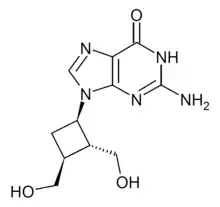Lobucavir
Lobucavir (previously known as BMS-180194, Cyclobut-G) is an antiviral drug that shows broad-spectrum activity against herpesviruses, hepatitis B and other hepadnaviruses, HIV/AIDS and cytomegalovirus.[1][2][3] It initially demonstrated positive results in human clinical trials against hepatitis B with minimal adverse effects but was discontinued from further development following the discovery of increased risk of cancer associated with long-term use in mice.[4] Although this carcinogenic risk is present in other antiviral drugs, such as zidovudine and ganciclovir that have been approved for clinical use, development was halted by Bristol-Myers Squibb, its manufacturer.[5]
 | |
| Clinical data | |
|---|---|
| Trade names | Lobucavir |
| Legal status | |
| Legal status | |
| Identifiers | |
| |
| CAS Number | |
| PubChem CID | |
| DrugBank | |
| ChemSpider | |
| UNII | |
| KEGG | |
| ChEMBL | |
| CompTox Dashboard (EPA) | |
| Chemical and physical data | |
| Formula | C11H15N5O3 |
| Molar mass | 265.27 g·mol−1 |
| 3D model (JSmol) | |
| |
| |
Medical use
Lobucavir has been shown to exhibit antiviral activity against herpesvirus, hepatitis B, HIV/AIDS, and human cytomegalovirus.[6] It reached phase III clinical trials for hepatitis B and herpesvirus, phase II clinical trials for cytomegalovirus, and underwent a pilot study for use in treating AIDs[7][8] prior to discontinuation.
Adverse effects
In early clinical trials, Lobucavir was relatively well tolerated in subjects and was not subject to discontinuation due to adverse effects. Commonly reported effects included headache, fatigue, diarrhea, abdominal pain, and flu-like symptoms common with other nucleoside analogs.[9] Other studies, however, identified Lobucavir-induced carcinogenesis associated with long-term use in mice that led to the drug's discontinuation in clinical trials in 1999.[4]
Mechanism of action
Lobucavir is a guanine analog that interferes with viral DNA polymerase.[6] It must be phosphorylated into its triphosphate form within infected cells via intracellular enzymes before it can demonstrate its anti-viral activity. In hepatitis B studies, Lobucavir has been found to inhibit viral primer synthesis, reverse-transcription, and DNA-dependent DNA polymerization by acting as a non-obligate chain terminator of the viral polymerase. Unlike traditional chain terminators that lack a 3'-OH group to prevent further DNA replication, Lobucavir is thought to cause a conformational change that blocks optimal polymerase activity two to three nucleotides downstream of its incorporation.[1] Its mechanism of action has been found to be similar in use against human cytomegalovirus.[6]
Pharmacokinetics
Lobucavir's bioavailability is 30-40% of the original oral dose and its half-life is approximately 10 hours, as demonstrated by pre-clinical testing[10][11]
References
- Seifer, Maria; Hamatake, Robert K.; Colonno, Richard J.; Standring, David N. (1998-12-01). "In Vitro Inhibition of Hepadnavirus Polymerases by the Triphosphates of BMS-200475 and Lobucavir". Antimicrobial Agents and Chemotherapy. 42 (12): 3200–3208. doi:10.1128/aac.42.12.3200. ISSN 0066-4804. PMC 106023. PMID 9835515.
- Field AK, Tuomari AV, McGeever-Rubin B, Terry BJ, Mazina KE, Haffey ML, et al. (January 1990). "(+-)-(1 alpha,2 beta,3 alpha)-9-[2,3-bis(hydroxymethyl)-cyclobutyl] guanine [(+-)-BHCG or SQ 33,054]: a potent and selective inhibitor of herpesviruses". Antiviral Research. 13 (1): 41–52. doi:10.1016/0166-3542(90)90043-7. PMID 2159261.
- Hoffman VF, Skiest DJ (February 2000). "Therapeutic developments in cytomegalovirus retinitis". Expert Opinion on Investigational Drugs. 9 (2): 207–20. doi:10.1517/13543784.9.2.207. PMID 11060672. S2CID 6621431.
- Woicke J, Durham SK, Mense MG (November 2007). "Lobucavir-induced proliferative changes in mice". Experimental and Toxicologic Pathology. 59 (3–4): 197–204. doi:10.1016/j.etp.2007.09.002. PMID 17942294.
- "Bristol-Myers Squibb Issues Statement On Lobucavir". www.pharmaceuticalonline.com. Retrieved 2020-03-14.
- Tenney, D J; Yamanaka, G; Voss, S M; Cianci, C W; Tuomari, A V; Sheaffer, A K; Alam, M; Colonno, R J (1997). "Lobucavir is phosphorylated in human cytomegalovirus-infected and -uninfected cells and inhibits the viral DNA polymerase". Antimicrobial Agents and Chemotherapy. 41 (12): 2680–2685. doi:10.1128/aac.41.12.2680. ISSN 0066-4804. PMC 164188. PMID 9420038.
- "Lobucavir - AdisInsight". adisinsight.springer.com. Retrieved 2020-03-14.
- "A Study of Lobucavir in Patients With AIDS - Full Text View - ClinicalTrials.gov". clinicaltrials.gov. Retrieved 2020-03-14.
- Mills, John. (1999). Antiviral chemotherapy : new directions for clinical application and research. Elsevier. ISBN 0-306-46107-2. OCLC 164814252.
- Yamanaka, Gregory; Wilson, Todd; Innaimo, Steven; Bisacchi, Gregory S.; Egli, Peter; Rinehart, J. Kent; Zahler, Robert; Colonno, Richard J. (January 1999). "Metabolic Studies on BMS-200475, a New Antiviral Compound Active against Hepatitis B Virus". Antimicrobial Agents and Chemotherapy. 43 (1): 190–193. doi:10.1128/AAC.43.1.190. ISSN 0066-4804. PMC 89048. PMID 9869593.
- "AIDS Related Opportunistic Infections Report, 1998". Treatment Action Group. Retrieved 2020-03-14.